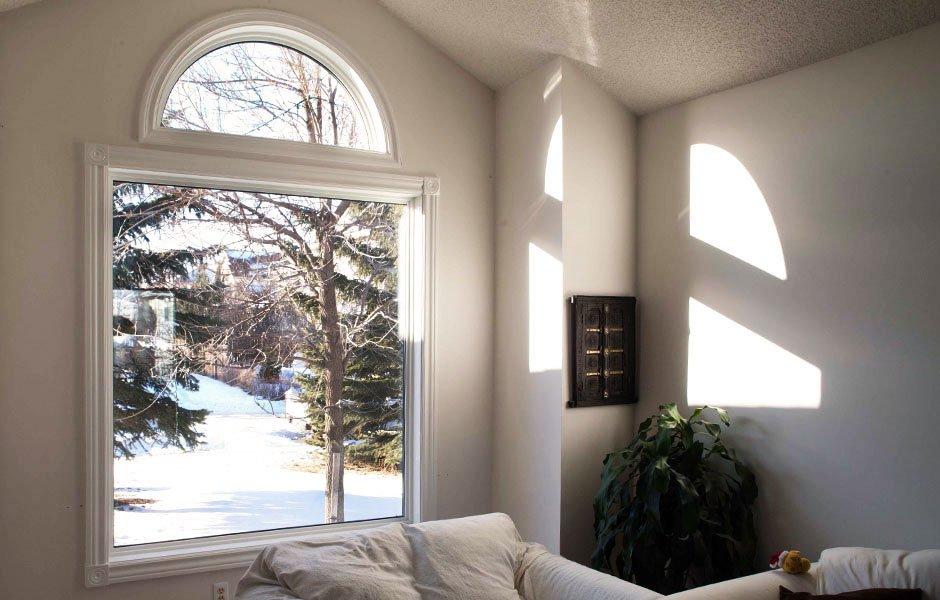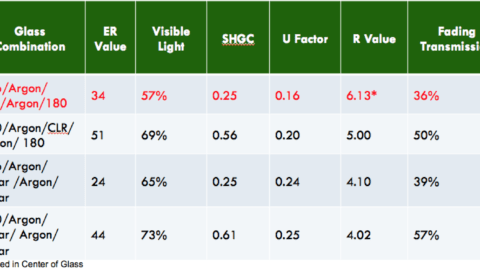It is no secret that a window replacement is a good step toward improving the energy efficiency of your home. Understanding what options are beneficial for windows in Edmonton is crucial in not only making your home comfortable but also hopefully keeping the window prices down so you get exactly the features you need.
Although you may be replacing the windows in the whole or part of a house, you should still consider how each window will affect a respective room. We’ve discussed appropriate window placement in the house, and maximizing Solar Heat Gains (SHGC) in an earlier post. But are there ways you can pay less for certain windows in the house? One way do this is to only get additional efficiency features only for windows that need them. This strategy works well when considering Low-emissivity coatings for different windows.
As a note: For comparison reasons, we will be discussing triple pane windows in this post. They are fast becoming the standard in many parts of the country. A big advantage of triple pane windows, besides the added warmth of an extra glazing, is that the extra space can be utilized for additional features. Customers generally need triple pane windows in Edmonton to meet climate zone requirements as outlined by Energy Star.
Low-E or low-emissivity coating is a special coating applied to one or more of the glazings in your window. What kind of coating, and in how many glazings it is used, makes all the difference in the performance of a window. Recent studies on the effectiveness of ER Ratings have discovered that window technology today has greatly surpassed the demands of the harsh Canadian climate. So most homeowners end up utilizing Low-E in their homes to prevent rooms from overheating and fading
Low-E 180
This is a standard single layer application of the coating. Low-E 180 is great because it provides overall high ER values for your windows with an accent on solar heat gains. This kind of coating is ideal for use on east, west, and north facing windows.
Double Low-E
An application of two Low-E coatings on separate glazings allows for even better energy efficiency. The key to Double Low-E, however, is its significant reduction of visibility and UV penetration, which in turn helps keep your rooms from overheating in the winter. Another benefit of double Low-E is its ability to significantly decrease fading from the sun. The use of this application is ideal on south-facing windows, that get a lot of sun year-round.
Low-E 366
This type of Low-E coating is designed specifically with sun blocking in mind. Windows with Low-E 366 are not necessarily as energy efficient as the Low-E 180 counterparts. These applications are usually used in extreme conditions for windows with maximum sunlight exposure, no trees or plants around, in houses at high altitude locations.
Although there are several other options for even better energy efficiency and UV transmission, these three are the most common purchased choices.
The chart below demonstrates all the available options, and ratings for different Low-E coatings:
Remember, the price difference in Low-E prices depends entirely on the size of the glazing that needs to be covered. While an upgrade from single Low-E application to double may be negligible in small windows, it could be well over a hundred dollars on the larger windows in your home. If you are replacing windows in the whole house, this can add up to quite a bit of money. Knowing how these coating applications can benefit your windows, can maximize the comfort levels in your home, and potentially save you some money.
Find out more about replacement windows:
Learn how much a new window project should cost
See our full line of window styles
Check out other features and options that make windows energy efficient


